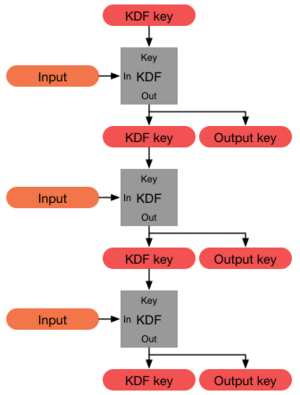
In cryptography, forward secrecy (FS), also known as perfect forward secrecy (PFS), is a feature of specific key-agreement protocols that gives assurances that session keys will not be compromised even if long-term secrets used in the session key exchange are compromised, limiting damage. For HTTPS, the long-term secret is typically the private key of the server. Forward secrecy protects past sessions against future compromises of keys or passwords. By generating a unique session key for every session a user initiates, the compromise of a single session key will not affect any data other than that exchanged in the specific session protected by that particular key. This by itself is not sufficient for forward secrecy which additionally requires that a long-term secret compromise does not affect the security of past session keys.
Forward secrecy protects data on the transport layer of a network that uses common transport layer security protocols, including OpenSSL,[1] when its long-term secret keys are compromised, as with the Heartbleed security bug. If forward secrecy is used, encrypted communications and sessions recorded in the past cannot be retrieved and decrypted should long-term secret keys or passwords be compromised in the future, even if the adversary actively interfered, for example via a man-in-the-middle (MITM) attack.
The value of forward secrecy is that it protects past communication. This reduces the motivation for attackers to compromise keys. For instance, if an attacker learns a long-term key, but the compromise is detected and the long-term key is revoked and updated, relatively little information is leaked in a forward secure system.
The value of forward secrecy depends on the assumed capabilities of an adversary. Forward secrecy has value if an adversary is assumed to be able to obtain secret keys from a device (read access) but is either detected or unable to modify the way session keys are generated in the device (full compromise). In some cases an adversary who can read long-term keys from a device may also be able to modify the functioning of the session key generator, as in the backdoored Dual Elliptic Curve Deterministic Random Bit Generator. If an adversary can make the random number generator predictable, then past traffic will be protected but all future traffic will be compromised.
The value of forward secrecy is limited not only by the assumption that an adversary will attack a server by only stealing keys and not modifying the random number generator used by the server but it is also limited by the assumption that the adversary will only passively collect traffic on the communications link and not be active using a man-in-the-middle attack. Forward secrecy typically uses an ephemeral Diffie–Hellman key exchange to prevent reading past traffic. The ephemeral Diffie–Hellman key exchange is often signed by the server using a static signing key. If an adversary can steal (or obtain through a court order) this static (long term) signing key, the adversary can masquerade as the server to the client and as the client to the server and implement a classic man-in-the-middle attack.[2]
- ^ "/docs/man1.1.1/man3/SSL_set_tmp_dh.html". www.openssl.org. Retrieved 2024-05-25.
- ^ "tls - Does Perfect Forward Secrecy (PFS) make Man-in-the-Middle (MitM) attacks more difficult?". Information Security Stack Exchange. Retrieved 2020-10-11.